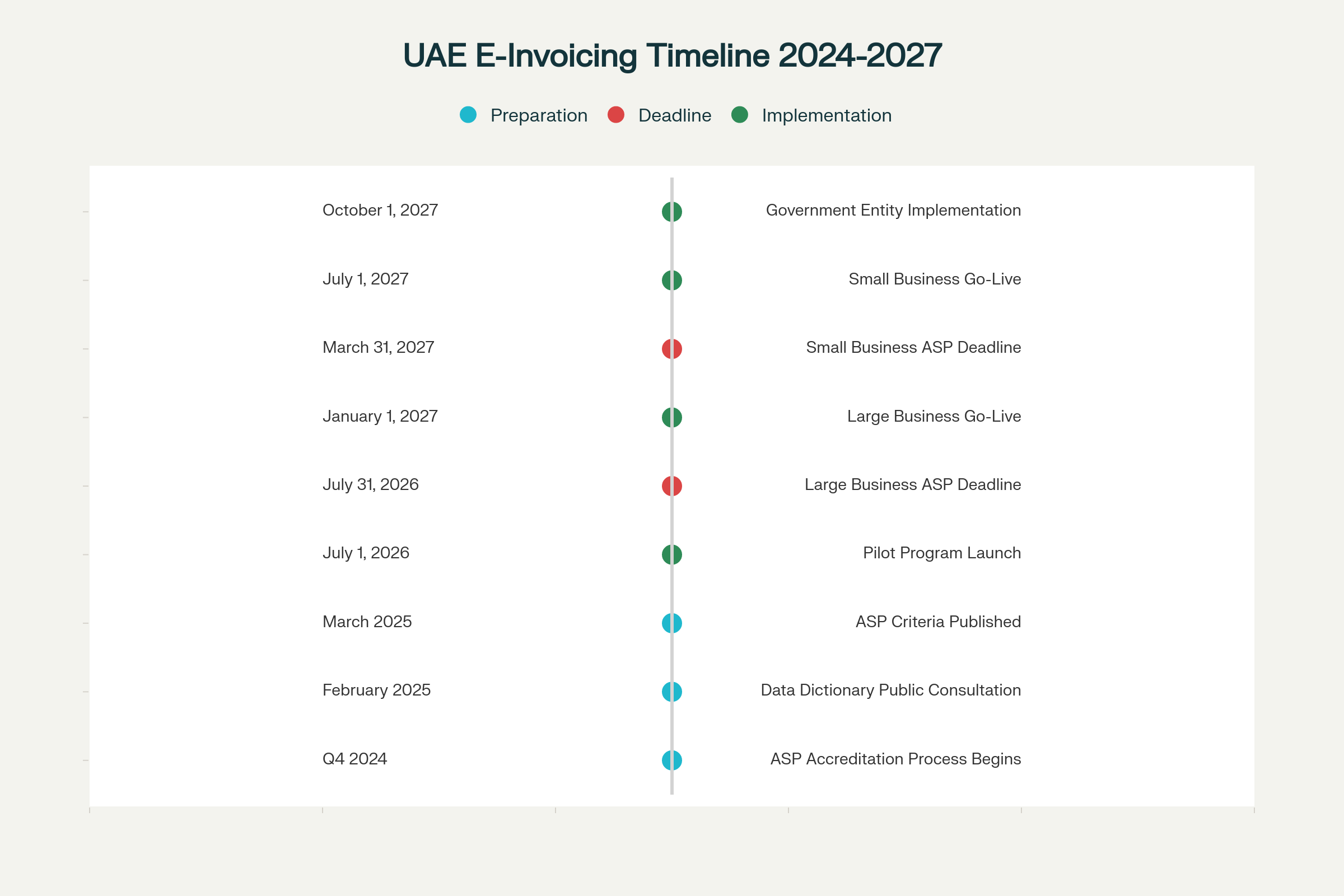UAE E-Invoicing Revolution: Your Complete Guide to the 2026 Digital Tax Transformation
This comprehensive guide covers the UAE's mandatory e-invoicing implementation starting July 2026, affecting all VAT-registered businesses. The post explains the phased rollout timeline, technical requirements for XML/JSON formatted invoices, Accredited Service Provider selection, and compliance challenges. Special focus on European multinational companies and their integration complexities, including ERP system compatibility, data sovereignty requirements, and strategic preparation steps. Key insights include ASP accreditation criteria, penalty structures, and opportunities for operational efficiency beyond basic compliance requirements.

Starting July 2026, the UAE is fundamentally changing how businesses handle invoices. This isn't just a digital upgrade – it's a complete overhaul of tax compliance that affects every VAT-registered company operating in the Emirates. The new Electronic Invoicing System (EIS) mandates that all business-to-business and business-to-government transactions must use structured digital invoices transmitted through government-approved service providers.
Here's the reality: traditional PDF invoices and paper documents will no longer count as valid tax invoices. Instead, you'll need XML or JSON formatted e-invoices that comply with international Peppol standards and flow through the Federal Tax Authority's real-time monitoring system. This shift impacts everyone from multinational corporations with UAE subsidiaries to local SMEs serving government clients.

What This Means for European Businesses in UAE
European companies have long valued the UAE's business-friendly environment, but the e-invoicing mandate introduces new operational complexities that require immediate attention. The phased implementation creates different timelines based on company size – large businesses with annual revenues of AED 50 million or more must be fully compliant by January 1, 2027, while smaller operations have until July 1, 2027.
The technical requirements are substantial. Every e-invoice must be created in machine-readable XML format using Universal Business Language (UBL) or Peppol International Invoice (PINT) standards. These aren't just format changes – they represent a complete shift in how invoice data is structured, validated, and transmitted to tax authorities.
European multinationals face particular challenges because their existing ERP systems, designed for European e-invoicing requirements, may not seamlessly integrate with UAE's specific technical standards. The UAE requires invoices to be in English, follow specific timestamp protocols, meet local sequencing rules, and ensure compatibility with FTA validation processes. What worked in Germany or France won't automatically work in Dubai without significant customization.
The data sovereignty requirements add another layer of complexity. All invoice data must be stored within UAE borders, and businesses must use Accredited Service Providers (ASPs) that comply with the UAE's National Cloud Security Policy. This often means European companies can't simply extend their existing global e-invoicing solutions to cover their UAE operations.
Recent Regulatory Updates You Need to Know
The UAE government has moved quickly to establish the legal framework for e-invoicing. In September 2025, the Ministry of Finance published two critical ministerial decisions: Decision No. 243 establishing the Electronic Invoicing System and Decision No. 244 outlining the implementation timeline. These decisions provide the clearest picture yet of what compliance actually looks like.
The Federal Tax Authority has also published a list of pre-approved ASPs, currently including eight companies ranging from global firms like Deloitte to specialized e-invoicing providers like Cygnet Digital and ClearTax. This list will expand as more providers meet the stringent accreditation requirements, but businesses need to start evaluating and selecting their ASP partners now.
One significant development is the UAE's adoption of the "5-corner" Peppol model, which means invoices flow between suppliers, buyers, their respective access points, and the tax authority without requiring pre-clearance. This approach balances real-time monitoring with business efficiency, allowing transactions to proceed while ensuring tax compliance.
The penalty framework follows existing UAE tax law structures, with fines starting at AED 2,500 for failing to issue electronic invoices and escalating to AED 20,000 for repeated compliance failures. More importantly, invalid invoices may not be recognized for VAT input credit purposes, creating immediate cash flow implications for businesses that get this wrong.
Understanding ASP Requirements and Selection
Choosing the right Accredited Service Provider is perhaps the most critical decision businesses will make during this transition. ASPs must meet rigorous technical and financial standards, including OpenPeppol certification, minimum two years of e-invoicing experience, AED 50,000 paid-up capital, and compliance with ISO 27001 security standards.
The ASP selection process should consider several factors beyond basic compliance capabilities. Integration complexity varies significantly depending on your existing ERP systems – SAP, Oracle, Microsoft Dynamics, and other enterprise platforms each present unique challenges when connecting to Peppol networks. Some ASPs specialize in specific ERP integrations, while others offer more flexible API-based solutions that can adapt to various systems.
Cost structures also vary considerably among ASPs. While providers must offer 100 free invoice exchanges annually to support SMEs, high-volume businesses will pay transaction-based fees that can add up quickly. European companies processing thousands of invoices monthly should carefully evaluate pricing models and negotiate volume discounts early in the selection process.
Service level agreements become crucial when you consider that system downtime could render your invoices invalid for tax purposes. The FTA requires businesses to report system failures within two business days, but prevention is obviously preferable to remediation. Look for ASPs with proven uptime records and robust disaster recovery procedures.
Compliance Challenges and Strategic Solutions
The technical implementation challenges are significant but manageable with proper planning. Real-time data transmission requirements mean your invoice processing workflows need fundamental redesign. Traditional month-end batch processing won't work when the FTA expects near-instantaneous invoice validation and transmission.
Data integrity becomes paramount under the new system. Invoice tampering, whether intentional or accidental, can result in rejected transactions and compliance failures. The structured XML format reduces many manual errors, but it also exposes inconsistencies in product codes, tax classifications, and customer data that might have been overlooked in PDF-based systems.
Integration complexity often surprises businesses that assume their existing e-invoicing capabilities will translate smoothly to UAE requirements. The reality is more nuanced – while the underlying Peppol framework is internationally standardized, each country's implementation includes specific data fields, validation rules, and reporting requirements. UAE's data dictionary includes unique elements for local tax compliance that may not exist in European implementations.
Security concerns are heightened in the UAE context, where cybersecurity threats are significant and data protection requirements are strict. The mandatory use of ASPs adds an additional security layer, but it also creates new potential vulnerabilities in data transmission and storage. Companies need comprehensive security assessments covering their internal systems, ASP connections, and data residency compliance.
Implementation Timeline and Preparation Steps
The compressed timeline for large businesses – from ASP selection by July 31, 2026, to full implementation by January 1, 2027 – leaves little room for delays. European companies should begin their preparation immediately, focusing on gap analysis, vendor selection, and system integration planning.
The pilot program launching July 1, 2026, offers valuable learning opportunities for businesses selected to participate. Even if your company isn't chosen for the pilot, monitor the experiences of pilot participants to identify common implementation challenges and best practices.
Testing phases will be crucial for success. ASPs must complete extensive interoperability testing with the FTA's systems, but businesses also need to conduct their own end-to-end testing to ensure data accuracy and process reliability. This includes testing invoice generation, transmission, error handling, and credit note procedures under various scenarios.
Change management often receives insufficient attention in technical implementations, but e-invoicing affects multiple departments beyond just finance and tax teams. Sales personnel need training on new invoice requirements, procurement teams must understand supplier onboarding for electronic transactions, and IT staff require knowledge of new system dependencies and troubleshooting procedures.
Strategic Opportunities Beyond Compliance
While the immediate focus is on meeting regulatory requirements, forward-thinking companies are identifying broader business benefits from e-invoicing implementation. The structured data format enables more sophisticated analytics around customer payment patterns, product performance, and operational efficiency.
The real-time data flow to tax authorities actually benefits businesses through faster VAT refund processing and reduced audit complexity. When your invoice data is already validated and transmitted to the FTA in real-time, traditional VAT return preparation becomes largely automated, reducing compliance costs and human error risks.
Supply chain optimization opportunities emerge from standardized electronic document exchange. Companies that extend e-invoicing integration to purchase orders, delivery notes, and payment confirmations create end-to-end digital workflows that reduce processing time and improve cash flow management.
The move toward digital-first tax compliance also positions UAE businesses for future regulatory developments. Other GCC countries are watching the UAE's implementation closely, and regional harmonization of e-invoicing standards seems likely. Early adopters will have competitive advantages when similar requirements roll out in Saudi Arabia, Qatar, and other regional markets.
Looking Ahead: The New Normal
The UAE's e-invoicing mandate represents more than regulatory compliance – it's part of the country's broader digital transformation strategy outlined in UAE Vision 2031. The system will generate unprecedented visibility into economic activity, enabling more responsive government policy and supporting the transition toward a knowledge-based economy.
For businesses, the key insight is that e-invoicing success requires strategic thinking rather than just technical implementation. Companies that view this as an opportunity to modernize their financial processes, improve data quality, and enhance operational efficiency will find competitive advantages beyond mere compliance.
The timeline is aggressive but achievable with proper planning and execution. European businesses operating in the UAE should begin their preparation immediately, focusing on ASP selection, system integration planning, and organizational change management. The companies that get ahead of this transition will find themselves better positioned not just for UAE compliance, but for the broader digital transformation reshaping Middle Eastern business practices.






